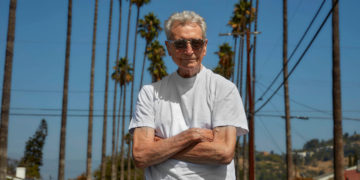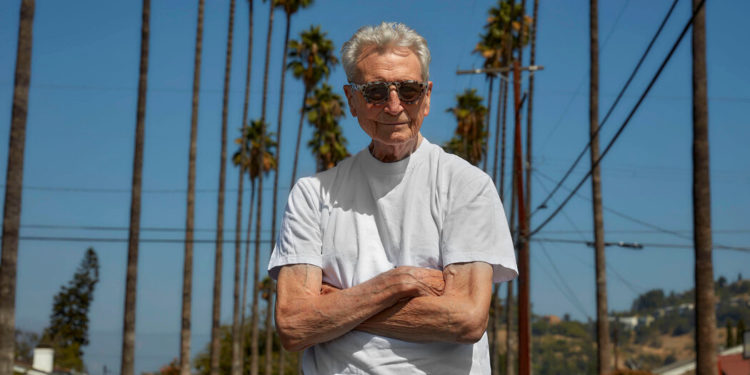Derek Boshier, who rose to prominence in the British Pop Art movement in the early 1960s and went on to make a pop statement of a different sort by collaborating with David Bowie and the Clash, died on Sept. 5 at his home in Los Angeles. He was 87.
His publicist, Daniel Bee, said the cause was cardiac arrest.
Proudly working-class and left-wing in his work, Mr. Boshier was among the vanguard of Britain’s analogue to the Pop Art movement centered in New York and defined by artists like Andy Warhol and Roy Lichtenstein.
As a student at the Royal College of Art in London in 1961, Mr. Boshier was featured in the landmark Young Contemporaries exhibition at the Whitechapel Gallery, alongside his current and former classmates David Hockney, Allen Jones, R.B. Kitaj and Peter Phillips, all of whom would help shape the movement.
The next year, Mr. Boshier played a prominent role in another seminal showcase of Pop Art on his side of the Atlantic: the BBC documentary “Pop Goes the Easel,” directed by Ken Russell, which also featured Mr. Phillips and the artists Pauline Boty and Peter Blake.
“All the Pop artists had different agendas,” Mr. Boshier said of the British movement in a 2012 video interview. “Peter Phillips and Peter Blake were celebrating American culture. Mine was always a critique.”
His art, he said, was influenced by the work of Marshall McLuhan, the Canadian philosopher who explored the dehumanizing effect of mass media, as well as related books like Vance Packard’s “The Hidden Persuaders” (1957) and Daniel Boorstin’s “The Image” (1962). A frequent target of his early paintings, he said, was “the Americanization of British culture.”
His 1961 painting “Situation in Cuba,” for example, showed a Cuban flag with the American flag eating into it. It was, he said, a commentary on President John F. Kennedy’s failed Bay of Pigs invasion.
“I Wonder What My Heroes Think of the Space Race,” a painting from the next year, depicted an American ballistic missile soaring from a planet where the land masses surrealistically drip like blood and into the sky, where images of Abraham Lincoln and Buddy Holly float among the clouds.
In the 1970s, Mr. Boshier turned his focus from painting to a variety of media, including film, three-dimensional collage and sculpture. Regardless, his work maintained its incisive quality.
His installation “Change,” from 1973, featured graphic abstractions morphing into Maoist red stars and visual references to police dogs attacking protesters in Apartheid-era South Africa, among other pointed political statements.
His career took a mass-market turn in 1979, when the British photographer Brian Duffy arranged for Mr. Boshier to meet David Bowie. At that point, Mr. Bowie had fled a life of cocaine-fueled excess in Los Angeles and was living in Berlin, where he channeled the avant-garde with a series of groundbreaking albums — later known as the Berlin Trilogy — working with the boundary-pushing musician Brian Eno and the producer Tony Visconti.
Mr. Bowie was looking for a an arresting image for the cover of “Lodger,” the third album in the trilogy. With Mr. Duffy and Mr. Bowie, Mr. Boshier came up with a conceptual photograph of Mr. Bowie, clad in a business suit, looking horrified, as if plummeting to his death.
To achieve the effect, Mr. Boshier situated Mr. Bowie on a table that was hidden from view by his body, and Mr. Duffy photographed him from above. Mr. Bowie’s contorted visage, seemingly pressed under glass, was in fact a result of wires drawn over his face.
Mr. Boshier also contributed to the sleeve for Mr. Bowie’s 1983 album “Let’s Dance,” which marked his transformation from art-rock explorer to MTV pop megastar. The cover featured one of Mr. Boshier’s paintings projected over an image of a shirtless Mr. Bowie, clad in boxing gloves and trunks.
The two maintained a friendship; as Mr. Boshier said in a 2019 interview with the online arts and culture magazine Cellophaneland, “He, over time, has become my best collector.”
Derek Walter Boshier was born on June 19, 1937, in Portsmouth, England, the only child of Walter and Winifred (Harvey) Boshier. His father was a Royal Navy veteran who later managed a pub with his wife.
As a youth, Derek had little interest in a creative life. “I’ve heard artists say, ‘I was drawing when I was 4,’” he said in a 2017 interview with the website Art Zealous. “That wasn’t me. I was a track athlete.”
He took up art in high school at the suggestion of an instructor and later attended the Royal College of Art, where he received a master’s degree in 1962.
During his career peak in the 1960s and ’70s, Mr. Boshier taught at the Central School of Art and Design in London. One of his students was John Mellor, who later refashioned himself as the punk-rock progenitor Joe Strummer, the fiery frontman of the Clash.
The band, known for its revolutionary stance, eventually hired Mr. Boshier to design its “2nd Songbook,” which included the musical notation and lyrics for its 1978 album, “Give ’Em Enough Rope.”
In 1980, Mr. Boshier moved to the United States, the country at which he had long taken shots. He taught at the University of Houston for 13 years, and during that time his work began to reflect the iconography of Texas — cowboys, oil derricks and gleaming Gulf Coast skyscrapers — and was exhibited at museums and galleries across the state.
He is survived by his wife, Thelma Gaskell, and his daughters, Rosa Boshier González and Lily Boshier, from his marriage to Patricia Gonzáles, which ended in divorce in 2001.
Mr. Boshier returned to London in 1992 and settled in Los Angeles five years later.
Later in life, Art Zealous asked him to name his biggest accomplishment over the decades. “I think the biggest is that I’m a survivor,” he said. “I’m still doing what I was doing at 16. That’s success.”
The post Derek Boshier, British Pop Artist and Bowie Collaborator, Dies at 87 appeared first on New York Times.



















